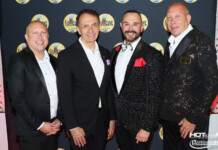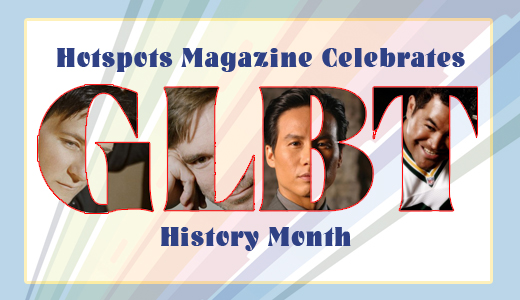
In the 1990’s, teachers and community organizations determined that a month should be designated for GLBT history. They chose October because public schools are in session and traditions, such as National Coming Out Day, occur then. GLBT History Month is endorsed by GLAAD, the Human Rights Campaign, the National Gay and Lesbian Task Force, the National Education Association, and other national organizations. In 2006, Equality Forum assumed responsibility for GLBT History Month.

In the 1990’s, teachers and community organizations determined that a month should be designated for GLBT history. They chose October because public schools are in session and traditions, such as National Coming Out Day, occur then.
GLBT History Month is endorsed by GLAAD, the Human Rights Campaign, the National Gay and Lesbian Task Force, the National Education Association, and other national organizations. In 2006, Equality Forum assumed responsibility for GLBT History Month.
The GLBT community is the only community worldwide that does not learn its history at home, in public schools or in religious institutions. GLBT History Month teaches our heritage, provides role models, builds community and makes the civil rights statement of our extraordinary national and international contributions.
Modeled after Black and Women’s History Months, GLBT History Month highlights annually the achievements of 31 gay, lesbian, bisexual or transgender Icons. Each year, the icons, living or dead, are selected for their achievements in their field of endeavor, their status as a national hero, or their significant contribution to GLBT civil rights. Equality Forum solicits nominations from state, national and international organizations and activists.
This year’s list of icons is: Alvin Ailey Jr., John Amaechi, Rep. Tammy Baldwin, John Cage, Ruth Ellis, Rainer Fassbinder, Michael Foucault, Harry Hay, Magnus Hirschfeld, Zora Neale Hurston, Jasper Johns, Cherry Jones, Kate Kendell, Alfred Kinsey, k.d. lang, Rachel Maddow, Deirdre McCloskey, Paul Monette, Pauli Murray, Joan Nestle, Todd Oldham, Suze Orman, Christine Quinn, Robert Rauschenberg, Jerome Robbins, Hilary Rosen, Yves St. Laurent, Esera Tuaolo, Urvashi Vaid, Gus Van Sant, and B.D. Wong.
The GLBT History Month Co-Chairs, Professor Sharon Ullman, History Department, Bryn Mawr College, and Professor Kenji Yoshino, New York University School of Law, review all nominations and recommend 31 Icons.
Equality Forum is a national and international GLBT civil rights organization with an educational focus. Equality Forum coordinates GLBT History Month, produces documentary films, undertakes high-impact initiatives and presents the largest annual international GLBT civil rights forum. For more information, visit www.equalityforum.com.
Equality Forum is accepting nominations for GLBT History Month 2010 Icons. Nominations should be submittted via e-mail to nominations @equalityforum.com by Friday, December 18, 2009.
Alfred Kinsey
Alfred Kinsey is known as the father of sexology. His groundbreaking and controversial research on human sexuality profoundly influenced social and cultural values.
Kinsey grew up in Hoboken, New Jersey, the oldest of three children in a devoutly religious home. His father was a strict disciplinarian and insisted the family attend church every Sunday.
In 1916, Kinsey graduated magna cum laude from Bowdoin College with degrees in biology and psychology. In 1919, he earned his doctorate in biology from Harvard University.
In 1920, Indiana University hired Kinsey as an assistant professor of zoology. The following year, Kinsey married Clara McMillen. The couple had four children.
Kinsey’s first 20 years of research focused on the study of gall wasps. His research methodology, which made an important contribution to entomology, carried over into his later research on human sexual behavior.
In 1940, as part of a marriage course he was teaching, Kinsey began conducting research on sexual behavior. Thereafter, Kinsey worked exclusively on his research. He and his staff conducted over 18,000 interviews. Kinsey published “Sexual Behavior in the Human Male” (1948), followed by “Sexual Behavior in the Human Female” (1953).
The two books, known as the “Kinsey Reports,” became best sellers and sparked a firestorm of controversy. Kinsey became an overnight celebrity, with articles about him in Time, Life, Look and McCall’s. Kinsey’s work planted the seed for the sexual revolution of the 1960’s.
Kinsey’s findings on homosexuality were among the most widely discussed. His studies found that 37% of American men had at least one homosexual experience. Kinsey devised a scale measuring sexual orientation, now known as the Kinsey Scale. The scale ranges from 0 to 6, with 6 designating someone exclusively homosexual, and 0 signifying someone exclusively heterosexual.
Kinsey had an intimate relationship with Clyde Martin, one of his research assistants. Martin also had a sexual relationship with Kinsey’s wife.
In 1947, Kinsey founded the Institute for Research in Sex, Gender and Reproduction at Indiana University—now the Kinsey Institute—one of the leading academic centers on human sexuality.
K.D. Lang
K.D. Lang is a singer/songwriter known for her stunning voice, androgynous look and brilliant performances. She has been a recording artist for over 25 years, winning four Grammy Awards and countless accolades from critics and audiences worldwide.
Born Kathryn Dawn Lang, she was raised in Consort, Alberta, on the Canadian prairie. After winning a childhood singing competition, Lang knew she was destined for a career as a vocalist. Starting in the country music genre, she earned a Juno Award (Canada’s equivalent to the Grammy) for Most Promising Female Vocalist in 1985.
“Angel with a Lariat,” her first U.S. album, received critical acclaim. Lang’s duet with Roy Orbison on his 60’s hit, “Crying,” turned her into a bonafide star. In 1989, the pair received a Grammy for Best Country Collaboration “Absolute Torch and Twang” (1989), another country album, won Lang her second Grammy. “Ingénue” (1992), a collection of pop contemporary vocals, was Lang’s most successful. The album went platinum, earning her a third Grammy and launching the hit single “Constant Craving.”
After touring with veteran crooner Tony Bennett in 2001, the duo collaborated on “A Wonderful World” (2002), a tribute to the music of Louis Armstrong. The album was honored with a Grammy for Best Traditional Pop Vocal Album.
Bennett described Lang as “a natural in the tradition of Bing Crosby—the best singer since Judy Garland.”
Lang has contributed music to a number of motion pictures, including Gus Van Sant’s “Even Cowgirls Get the Blues,” Clint Eastwood’s “Midnight in the Garden of Good and Evil,” and the James Bond film “Tomorrow Never Dies.”
In 1992, Lang came out in an interview with The Advocate. She has actively championed GLBT civil rights causes and helps raise funds for HIV/AIDS care and research.
In 2008, k.d. lang received a star on Canada’s Walk of Fame.
Watch for more information on GLBT History Month all Through October in Hotspots Magazine and LatinoBoysMagazine.com

















